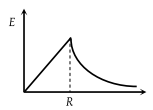An infinite number of electric charges each equal to \(5\) nC (magnitude) are placed along the \(x\text-\)axis at \(x=1\) cm, \(x=2\) cm, \(x=4\) cm, \(x=8\) cm ………. and so on. In the setup if the consecutive charges have opposite sign, then the electric field in Newton/Coulomb at \(x=0\) is: \(\left(\frac{1}{4 \pi \varepsilon_{0}} = 9 \times10^{9} ~\text{N-m}^{2}/\text{C}^{2}\right)\)
1. \(12\times 10^{4}\)
2. \(24\times 10^{4}\)
3. \(36\times 10^{4}\)
4. \(48\times 10^{4}\)
1. \(12\times 10^{4}\)
2. \(24\times 10^{4}\)
3. \(36\times 10^{4}\)
4. \(48\times 10^{4}\)
Three charges –q1, +q2 and –q3 are placed as shown in the figure. The x-component of the force on –q1 is proportional to
(1)
(2)
(3)
(4)
Two-point charges \(+q\) and \(–q\) are held fixed at \((–d, 0)\) and \((d, 0)\) respectively of a \((x, y)\) coordinate system. Then:
| 1. | \(E\) at all points on the \(y\text-\)axis is along \(\hat i\) |
| 2. | The electric field \(\vec E \) at all points on the \(x\text-\)axis has the same direction |
| 3. | The dipole moment is \(2qd\) directed along \(\hat i\) |
| 4. | The work has to be done to bring a test charge from infinity to the origin |
A point charge of \(40~\text{stat coulomb }\)is placed \(2~\text{cm}\) in front of an earthed metallic plane plate of large size. Then the force of attraction on the point charge is
1. \(100~\text{dynes}\)
2. \(160~\text{dynes}\)
3. \(1600~\text{dynes}\)
4. \(400~\text{dynes}\)
Which of the following graphs shows the variation of electric field E due to a hollow spherical conductor of radius R as a function of distance from the centre of the sphere
| 1. |  |
2. |  |
| 3. |  |
4. |  |
(1)
(2)
(3)
(4)
The electric field due to a uniformly charged solid sphere of radius R as a function of the distance from its centre is represented graphically by -
(1) 
(3) 
The electric field inside a spherical shell of uniform surface charge density is -
1. Zero
2. Constant, less than zero
3. Directly proportional to the distance from the centre
4. None of the above
The distance between charges 5 × 10–11 C and –2.7 × 10–11 C is 0.2 m. The distance at which a third charge should be placed in order that it will not experience any force along the line joining the two charges is
1. 0.44 m
2. 0.65 m
3. 0.556 m
4. 0.350 m
Suppose the charge of a proton and an electron differ slightly. One of them is \(\text- e\) and the other is \((e+\Delta e)\). If the net of electrostatic force and gravitational force between two hydrogen atoms placed at a distance \(d\) (much greater than atomic size) apart is zero, then \(\Delta e\)
1. \(10^{-20}~\text{C}\)
2. \(10^{-23}~\text{C}\)
3. \(10^{-37}~\text{C}\)
4. \(10^{-47}~\text{C}\)
Two identical charged spheres suspended from a common point by two massless strings of lengths l are initially at a distance d(d < < l) apart because of their mutual repulsion. The charges begin to leak from both the spheres at a constant rate. As a result, the spheres approach each other with a velocity v. Then, v varies as a function of the distance x between the sphere, as:
1. \(v \propto x\)
2. \(v \propto x^{\frac{-1}{2}}\)
3. \(v \propto x^{-1}\)
4. \(v \propto x^{\frac{1}{2}}\)













